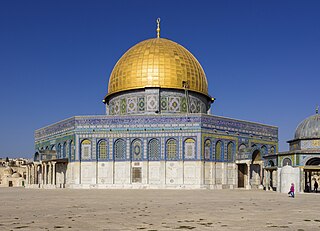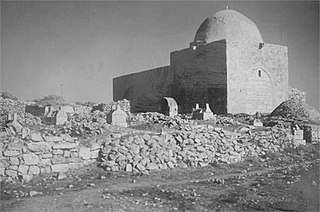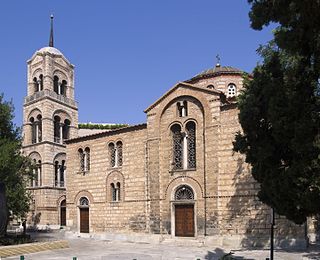Related Research Articles

The Church of the Holy Sepulchre is a church in the Christian Quarter of the Old City of Jerusalem. According to traditions dating back to the 4th century, it contains two sites considered holy in Christianity: the site where Jesus was crucified, at a place known as Calvary or Golgotha, and Jesus's empty tomb, which is where he was buried and resurrected. Each time the church was rebuilt, some of the antiquities from the preceding structure were used in the newer renovation. The tomb itself is enclosed by a 19th-century shrine called the Aedicule. The Status Quo, an understanding between religious communities dating to 1757, applies to the site.

The Temple Mount, also known as al-Ḥaram al-Sharīf, al-Aqsa Mosque compound, or simply al-Aqsa Mosque, and sometimes as Jerusalem's sacredesplanade, is a hill in the Old City of Jerusalem that has been venerated as a holy site in Judaism, Christianity, and Islam for thousands of years.

The Dome of the Rock is an Islamic shrine at the center of the Al-Aqsa Mosque compound on the Temple Mount in the Old City of Jerusalem, a site also known to Muslims as the Haram al-Sharif or Al-Aqsa. Its initial construction was undertaken by the Umayyad Caliphate on the orders of Abd al-Malik during the Second Fitna in 691–692 CE, and it has since been situated on top of the site of the Second Jewish Temple, which was destroyed by the Romans in 70 CE. The original dome collapsed in 1015 and was rebuilt in 1022–23. The Dome of the Rock is the world's oldest surviving work of Islamic architecture.

Al-Aqsa Mosque, properly Jāmiʿ al-Aqṣā, also known as the Qibli Mosque or Qibli Chapel, is a congregational mosque or prayer hall in the Old City of Jerusalem. In some sources the building is also named al-Masjid al-Aqṣā, but this name and its English translation "Al Aqsa Mosque" itself, is disputed as it can instead apply to the whole compound in which the building sits. The wider compound is also known as the Haram al-Sharif, the Al-Aqsa Mosque compound, and the Temple Mount.

Rachel's Tomb is a site revered as the burial place of the Biblical matriarch Rachel. The site is also referred to as the Bilal bin Rabah mosque. The tomb is held in esteem by Jews, Christians, and Muslims. The tomb, located at the northern entrance to the Palestinian city of Bethlehem, next to the Rachel's Tomb checkpoint, is built in the style of a traditional maqam, Arabic for shrine.
Beit Wazan is a Palestinian village in the Nablus Governorate in northern West Bank, located 4.5 kilometers west of Nablus. According to the Palestinian Central Bureau of Statistics (PCBS), the village had a population of 1,120 inhabitants in mid-year 2006.

The Great Mosque of Gaza, also known as the Great Omari Mosque is the largest and oldest mosque in the Gaza Strip, located in the Gaza's old city, in the State of Palestine.

Great Mosque of Nablus is the oldest and largest mosque in the Palestinian city of Nablus. It was originally built as a Byzantine church and was converted into a mosque during the early Islamic era. The Crusaders transformed it into a church in the 11th century, but it was reconsecrated as a mosque by the Ayyubids in the 12th century. The mosque is located at the intersection of the main streets of the Old City, along the district's eastern edges. It has a long, narrow, rectangular floor plan and a silver dome.

An-Nasr Mosque is a mosque located in the Palestinian city of Nablus. It is situated in the central square of the Old City and is donned as the "symbol of Nablus". An-Nasr Mosque has a turquoise dome and its prayer room is located in the second floor of the building.

The Jerusalem Waqf and Al-Aqsa Mosque Affairs Department, also known as the Jerusalem Waqf, the Jordanian Waqf or simply the Waqf, is the Jordanian-appointed organization responsible for controlling and managing the current Islamic edifices on the Temple Mount in the Old City of Jerusalem, known to Muslims as the Al-Aqsa Mosque, which includes the Dome of the Rock. The Jerusalem Waqf is guided by a council composed of 18 members and headed by a director, all appointed by Jordan. The current director of the Waqf, since 2005, is Sheikh Azzam al-Khatib.
The Near East earthquakes of 1759 were a series of devastating earthquakes that shook a large portion of the Levant in October and November of that year. This geographical crossroads in the Eastern Mediterranean were at the time under the rule of the Ottoman Empire. The ruins of Baalbek, a settlement in the Beqaa Valley of Lebanon east of the Litani River, were badly damaged. These 1759 events, along with the earlier 1202 Syria earthquake, are likely the strongest historical earthquakes in the region.

A devastating earthquake known in scientific literature as the Earthquake of 749 struck on January 18, 749, in areas of the Umayyad Caliphate, with the epicenter in Galilee. The most severely affected areas were parts of Palestine and western Transjordan. The cities of Tiberias, Beit She'an, Pella, Gadara, and Hippos were largely destroyed while many other cities across the Levant were heavily damaged. The casualties numbered in the tens of thousands.
The 1927 Jericho earthquake was a devastating event that shook Mandatory Palestine and Transjordan on July 11 at 15:04 local time. The epicenter of the earthquake was in the northern area of the Dead Sea. The cities of Jerusalem, Jericho, Ramle, Tiberias, and Nablus were heavily damaged and at least 287 were estimated to have been killed.
The timeline of the Palestine region is a timeline of major events in the history of Palestine. For more details on the history of Palestine see History of Palestine. In cases where the year or month is uncertain, it is marked with a slash, for example 636/7 and January/February.

The Islamization of Jerusalem refers to the process through which Jerusalem and its Old City adopted an Islamic atmosphere of influence and eventually a significant Muslim presence. The foundation for Jerusalem's Islamization was laid by the Muslim conquest of the Levant, and began shortly after the city was besieged and captured in 638 CE by the Rashidun Caliphate under Umar ibn al-Khattab, the second Rashidun caliph. The second wave of Islamization occurred after the fall of the Kingdom of Jerusalem, a Christian state that was established after the First Crusade, at the Battle of Hattin in 1187. The eventual fall of the Crusader states by 1291 led to a period of almost-uninterrupted Muslim rule that lasted for seven centuries, and a dominant Islamic culture was consolidated in the region during the Ayyubid, Mamluk and early Ottoman periods. Beginning in the late Ottoman era, Jerusalem’s demographics turned increasingly multicultural, and regained a Jewish-majority character during the late-19th and early-20th centuries that had not been seen since the Roman period, which largely ended the Jewish presence in the region.

The Mughrabi Bridge is a wooden bridge connecting the Western Wall Plaza with the Mughrabi Gate of the Temple Mount in Jerusalem.

The Al-Aqsa Mosque compound in the Old City of Jerusalem has four minarets in total: three on the western flank and one on the northern flank.

The Church of the Holy Trinity is a Byzantine-era church at Filellinon Street that serves the Russian Orthodox community of Athens, Greece.

The Church of Saint Irene, also known as Hagia Irene or Hagia Eirene, is an Eastern Orthodox church in the city of Athens, Greece, built on the site of an older medieval church, located on Aiolou Street. It is dedicated to Saint Irene, and served as the metropolis of the new Greek state during the early years of independence in the 19th century. Saint Irene is venerated on May 5.